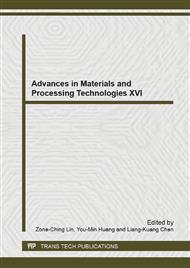p.152
p.161
p.169
p.177
p.186
p.194
p.201
p.209
p.214
Bonding PDMS Microfluidic Devices to PMMA and Glass Substrate Using Pulsed UV Laser Technology
Abstract:
This study presents a new method for surface modification of polymeric materials by using pulsed UV laser welding technology. The bonding procedures including ablation treatment, Oxygen plasma treatment, adhesive layer bonding and cured by pulsed UV laser writing system was exhibited. The investigation of various parameters for UV laser writing system was performed and discussed by using water contact angle measurement. This technique has been successfully applied to bond dissimilar polymer substrates (polydimethylsiloxane (PDMS) to polymethylmethacrylate (PMMA)). The scanning electron microscopy (SEM) image reveals clearly that there was no clogging in the microchannel or deformation observed between PDMS and PMMA. The method was straightforward and the integrity of microfluidic features was successfully preserved after bonding.
Info:
Periodical:
Pages:
186-193
Citation:
Online since:
May 2014
Authors:
Keywords:
Price:
Сopyright:
© 2014 Trans Tech Publications Ltd. All Rights Reserved
Share:
Citation:


